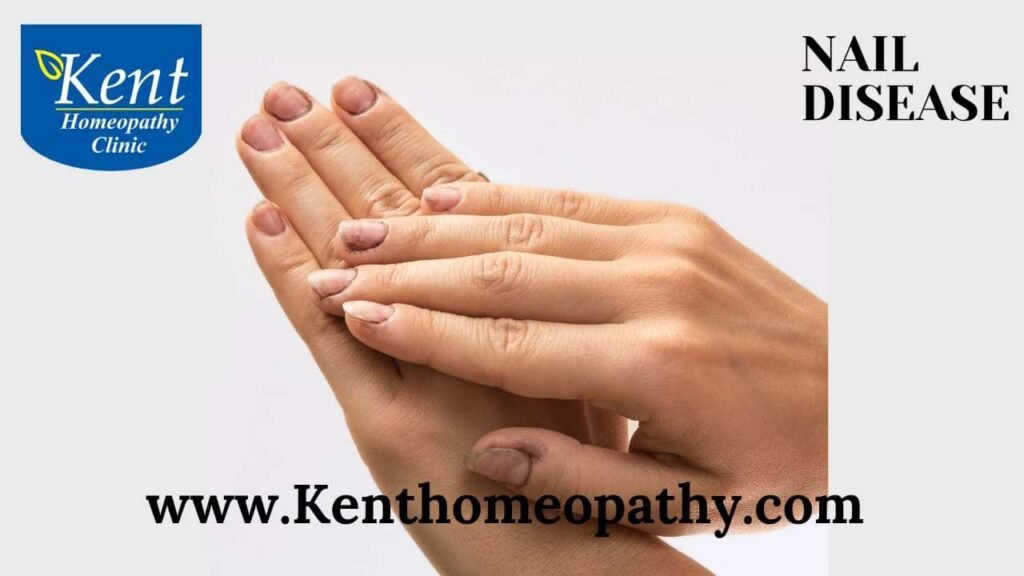Nail disorders

Nail Disorders: Unveiling Symptoms, Causes, and Types
Nail disorders encompass a range of conditions affecting the nails, which can include changes in color, texture, thickness, or shape. These disorders can result from various factors, including infections, underlying health conditions, trauma, or genetic predispositions. Understanding the symptoms, causes, and types of nail disorders is vital for accurate diagnosis and appropriate management.
Symptoms:
- Changes in Color: Discoloration of the nails is a common symptom of nail disorders. Nails may appear yellow, brown, green, or even have white spots or streaks.
- Changes in Thickness: Abnormal thickening or thinning of the nails can occur. Thickened nails may be difficult to trim, while thin nails may be more prone to breakage.
- Changes in Texture: Alterations in the texture of the nails can manifest as ridges, pitting, grooves, or brittleness. Smooth, even texture is characteristic of healthy nails.
- Changes in Shape: Abnormalities in nail shape, such as clubbing (enlargement and rounding of fingertips), spooning (concave shape), or pincer nails, may indicate an underlying disorder.
- Pain or Discomfort: Some nail disorders can cause pain or discomfort, especially if there is an infection, ingrown nail, or injury.
- Separation from Nail Bed: Onycholysis refers to the separation of the nail from the underlying nail bed. This can result in a gap between the nail and the flesh.
- Swelling and Inflammation: Inflammatory conditions may cause swelling around the nails, redness, and tenderness.
- Brittle or Crumbly Nails: Nails that are excessively brittle or crumbly may indicate nutritional deficiencies, fungal infections, or other underlying issues.
Causes:
- Fungal Infections: Fungal infections, particularly onychomycosis, are a common cause of nail disorders. Fungi thrive in warm, moist environments, making nails susceptible to infection.
- Bacterial Infections: Bacterial infections, such as paronychia, can lead to redness, swelling, and pus around the nail.
- Viral Infections: Viruses like the human papillomavirus (HPV) can cause warts around or under the nails.
- Trauma: Physical trauma to the nails, such as crushing, slamming, or repetitive stress, can lead to various nail disorders, including subungual hematoma or traumatic nail dystrophy.
- Psoriasis: Psoriasis, an autoimmune condition, can affect the nails, causing pitting, ridges, and discoloration.
- Eczema (Dermatitis): Eczema or dermatitis can lead to redness, itching, and inflammation around the nails.
- Lichen Planus: Lichen planus is an inflammatory condition that can affect the nails, leading to ridges, grooves, and discoloration.
- Nutritional Deficiencies: Inadequate intake of essential nutrients like biotin, iron, or zinc can contribute to nail disorders.
- Systemic Diseases: Conditions such as diabetes, thyroid disorders, and autoimmune diseases can manifest with nail abnormalities.
- Medications: Certain medications, including chemotherapy drugs, antibiotics, and antifungal medications, can affect nail health.
- Allergies: Allergic reactions to nail products, such as nail polish or acrylic nails, can lead to nail disorders.
Types:
- Onychomycosis (Fungal Nail Infection):
– Symptoms: Thickened, discolored nails with possible brittleness.
– Causes: Fungal infections by dermatophytes, yeast, or molds.
– Treatment: Antifungal medications, topical or oral, are commonly used.
- Paronychia (Bacterial Infection):
– Symptoms: Redness, swelling, and pus around the nail.
– Causes: Bacterial infection, often due to injury, nail biting, or exposure to irritants.
– Treatment: Warm soaks, antibiotics for bacterial infections.
- Ingrown Toenail (Onychocryptosis):
– Symptoms: Pain, redness, and swelling along the nail edge.
– Causes: Nails growing into the surrounding skin, often due to improper trimming or tight shoes.
– Treatment: Warm soaks, proper nail trimming, antibiotics for infections, or surgical intervention in severe cases.
- Psoriatic Nails (Psoriasis):
– Symptoms: Pitting, ridges, discoloration, and separation from the nail bed.
– Causes: Psoriasis, an autoimmune condition affecting the skin and nails.
– Treatment: Topical or systemic medications to manage psoriasis.
- Lichen Planus Nails:
– Symptoms: Ridging, grooving, and nail thinning.
– Causes: Lichen planus, an inflammatory skin condition.
– Treatment: Topical or systemic steroids, depending on the severity.
- Onychogryphosis (Ram’s Horn Nails):
– Symptoms: Overgrowth of the nails, leading to a curved or horn-like appearance.
– Causes: Often associated with neglect, trauma, or underlying health conditions.
– Treatment: Regular trimming, management of underlying causes.
- Yellow Nail Syndrome:
– Symptoms: Yellow discoloration, thickening, and slow growth of nails.
– Causes: Respiratory or lymphatic conditions leading to poor nail growth.
– Treatment: Addressing underlying health conditions, nutritional support.
- Beau’s Lines:
– Symptoms: Transverse depressions or ridges across the nails.
– Causes: Interrupted nail growth due to severe illness, trauma, or systemic conditions.
– Treatment: Managing underlying causes, as Beau’s lines grow out with time.
- Koilonychia (Spoon Nails):
– Symptoms: Concave or spoon-shaped nails.
– Causes: Iron deficiency anemia, hemochromatosis, or certain genetic conditions.
– Treatment: Addressing underlying causes, iron supplementation if needed.
Contact to know more
Contact
Timings
Monday to Saturday:
11:00 AM to 02:30 PM
06:30 PM to 09:00 PM
